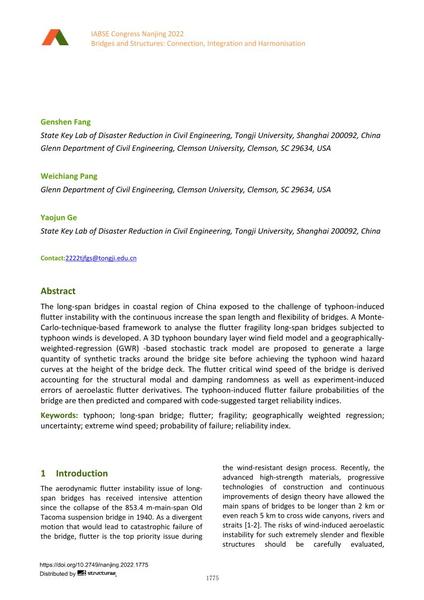Flutter Fragility Analysis of Long-Span Bridges Based on 3D Typhoon Model Using Geographically Weighted Regression

|
|
|||||||||||
Détails bibliographiques
| Auteur(s): |
Genshen Fang
(State Key Lab of Disaster Reduction in Civil Engineering, Tongji University, Shanghai 200092, China Glenn Department of Civil Engineering, Clemson University, Clemson, SC 29634, USA)
Weichiang Pang (Glenn Department of Civil Engineering, Clemson University, Clemson, SC 29634, USA) Yaojun Ge (State Key Lab of Disaster Reduction in Civil Engineering, Tongji University, Shanghai 200092, China) |
||||
|---|---|---|---|---|---|
| Médium: | papier de conférence | ||||
| Langue(s): | anglais | ||||
| Conférence: | IABSE Congress: Bridges and Structures: Connection, Integration and Harmonisation, Nanjing, People's Republic of China, 21-23 September 2022 | ||||
| Publié dans: | IABSE Congress Nanjing 2022 | ||||
|
|||||
| Page(s): | 1775-1783 | ||||
| Nombre total de pages (du PDF): | 9 | ||||
| DOI: | 10.2749/nanjing.2022.1775 | ||||
| Abstrait: |
The long-span bridges in coastal region of China exposed to the challenge of typhoon-induced flutter instability with the continuous increase the span length and flexibility of bridges. A Monte- Carlo-technique-based framework to analyse the flutter fragility long-span bridges subjected to typhoon winds is developed. A 3D typhoon boundary layer wind field model and a geographically- weighted-regression (GWR) -based stochastic track model are proposed to generate a large quantity of synthetic tracks around the bridge site before achieving the typhoon wind hazard curves at the height of the bridge deck. The flutter critical wind speed of the bridge is derived accounting for the structural modal and damping randomness as well as experiment-induced errors of aeroelastic flutter derivatives. The typhoon-induced flutter failure probabilities of the bridge are then predicted and compared with code-suggested target reliability indices. |
||||
| Copyright: | © 2022 International Association for Bridge and Structural Engineering (IABSE) | ||||
| License: | Cette oeuvre ne peut être utilisée sans la permission de l'auteur ou détenteur des droits. |
||||
